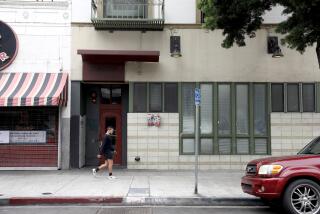Skid Rowers Don’t Deserve the Boot
The poor of skid row are down and soon to be out. The city has cast its lot with developers and bankers who want to reclaim skid row for the rich.
How is it in anyone’s interest for a handful of developers to reap huge financial windfalls by purchasing old buildings on skid row’s 50 blocks? With little down, often borrowing off inflated prices, pockets full of public tax and financial incentives, these opportunists will inflict lasting pain and financial burden on the rest of the city.
Skid row’s 65 single-room-occupancy hotels are home to nearly 8,000 of the area’s 11,000 elderly, handicapped and single poor. If Los Angeles had a surplus of affordable housing for skid rowers, whose income often is a $223 monthly relief check, demolishing many of skid row’s SRO hotels might be sound public policy. But Los Angeles does not.
Loss of the existing 6,500 rooms would leave the city facing the massive and costly task of providing ongoing emergency shelter for the 8,000 poor who right now pay their own rent.
The city’s elite once lived in estates on Main and Los Angeles streets. Construction of rail lines at Central between 4th and 6th streets spurred the building of rooming houses, tenements, saloons and commercial businesses along 5th Street. By the time of the Depression, the city’s poorest had moved in to stay.
Alarmed by deteriorating physical conditions on skid row in the late 1950s, the city demolished 5,500 hotel rooms and apartments and then complained that the homeless took to sleeping on city sidewalks. This shortsighted policy was wisely reversed when the Central City Community Plan in 1974 and the Central Business District Redevelopment Project of 1975 were adopted. The highest priority became a comprehensive solution to the skid row problem--attention was turned to the human dimension and decent housing through rehabilitation and new construction. Every community redevelopment plan over the past 25 years has reaffirmed this commitment.
Yet, in its new plan, the city seems not to think of skid row’s human dimension. Indeed, it does not even mention skid row. Instead, as though struck by a collective short-term memory loss, the city divides Main Street in half and no longer regards three major hotels there as SROs. Instead, the three hotels can be turned into mixed-income housing.
For City Hall to abandon 30 years of planning and several hundred million dollars already invested in implementing those plans is economically as well as socially irresponsible.
As early as 1974, the city concluded that dispersing skid row residents would cause horrific economic and social harm to everyone in the city. Skid rowers have to live somewhere. If the large SROs on Main Street are not protected, the homeless of skid row will spread throughout the city, sleeping in whatever parks and neighborhood lawns they can find.
More than one-third of all skid row housing is in the Main Street area. The new plan must be directed toward retention and rehabilitation of this irreplaceable housing for skid rowers. The affluent, on whose behalf skid row’s dwindling SROs are being converted to lofts, can live 15 minutes away in Pasadena or Santa Monica. They have options.
Skid row is the last place where a community’s poorest can find free or cheap housing, free food and free clothing. The new plan is written as though skid row and its human misery are not a concern of economic and social importance.
A city is a great city not because its poor cannot be seen but because its poor can be seen living in places of dignity.
More to Read
Sign up for Essential California
The most important California stories and recommendations in your inbox every morning.
You may occasionally receive promotional content from the Los Angeles Times.










